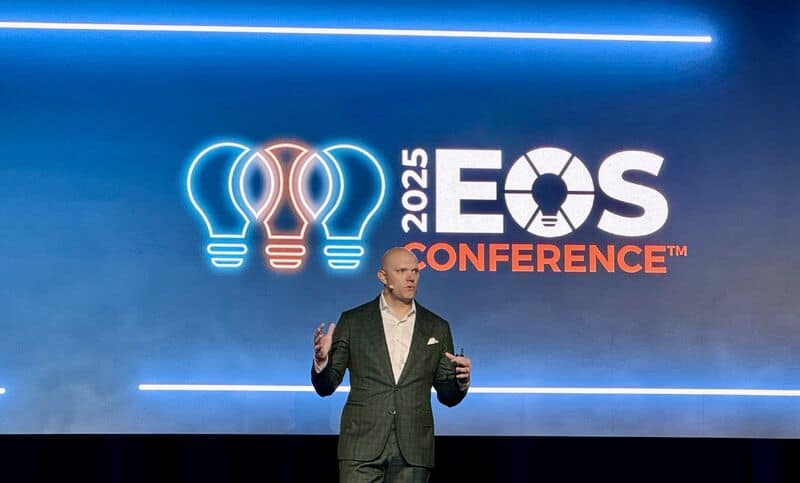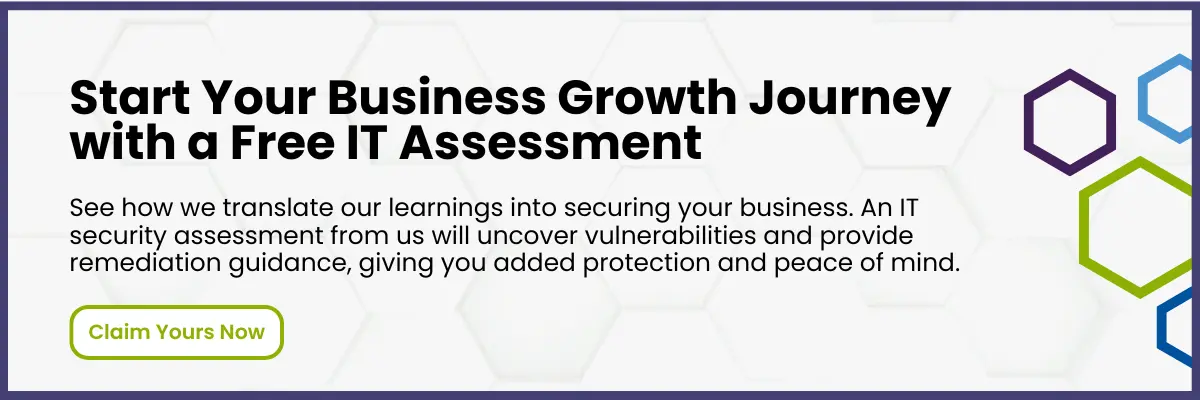This year marked Anderson Technologies’ third attendance at the annual EOS Worldwide Conference. As managed IT service providers, we’re constantly seeking ways to enhance our operations and service delivery—and this event never disappoints.
As you might’ve seen on our LinkedIn, our team left the event feeling energized, inspired, and ready to implement invaluable nuggets that will directly benefit our team and our clients. But what exactly did we learn, and how will it translate to improved IT support for your business?
Here are five key takeaways and their practical applications.
Hold On – What’s EOS?
For those unfamiliar, EOS (Entrepreneurial Operating System) is a business operating system designed to help organizations clarify, simplify, and achieve their vision.
At its heart, EOS aims to strengthen leadership teams’ ability to effectively drive their organizations forward. We’ve implemented EOS at Anderson Technologies because we believe that a well-structured business delivers better results for clients—and the annual conference only reinforced that belief.
Lesson #1: We Love Relating to Other Businesses
Alright, we knew that already—but the conference reminded us how much of a difference it makes when your partners speak the same language as you.
Being surrounded by other business leaders who had experienced the same hiccups and frustration points with implementing EOS made us feel less alone—the same way we want to make businesses struggling with IT management feel.
If we’d spent the whole event being spoken down to by people who claimed to know it all (but couldn’t actually explain anything in terms that made sense to us), we might’ve been tempted not to go back.
Unfortunately, that’s the experience many of our clients have had with previous IT support providers. It leaves them believing streamlined IT that actually drives their operations forward is unattainable—when that couldn’t be further from the truth.
Our takeaway?
It Pays to Be Human, Especially When It Comes to Technology
Too often in the IT industry, we see providers who focus solely on technical specifications while forgetting there are actual humans trying to use the technology.
In response, we’re doubling down on our commitment to approachable, jargon-free communication. When we explain technical concepts, we do so in a way that empowers rather than confuses our clients.
This human-centered approach extends to how we handle support tickets, conduct training sessions, and design technology solutions. After all, the most technically perfect solution is worthless if your team can’t use it effectively.
Lesson #2: Successful Growth Requires a Proven Strategy
This year’s keynote speakers were an absolute highlight for us.
The founder of EOS, Gino Wickman, talked about how using proven methods allowed him to handle impressive growth and scale without significant issues. His methodical approach to expansion applies on a wider business level, but it’s also a great one to bear in mind when you’re undergoing digital transformation projects.
From the “Beyond Gut Instinct” session, we were particularly struck by the Goals & Strategy portion of the Financial Flywheel concept. The speaker emphasized the importance of budgeting based on 3–5-year targets—and this forward-thinking approach is exactly what we aim to instill in our IT planning conversations with clients.
“Where Should You Invest Today to Meet Your Goals Tomorrow?”
- Rather than simply reacting to their immediate needs, our goal is to help the businesses we work with align their technology investments with their long-term objectives.For example, if your business aims to double in size within three years, your current network infrastructure might be insufficient for that growth. By planning those upgrades strategically—perhaps implementing them in phases—you can avoid both immediate budget strain and future productivity bottlenecks.
Lesson #3: We Scale Mountains One Step at a Time
“Excellence is not about radical change but accruing small improvements over time.” That quote from Atomic Habits author James Clear’s keynote resonated deeply with our team. Big changes don’t happen overnight, but by taking intentional steps to improve every day, we allow our future selves to look back and think, “Wow, look how far we’ve come.”
Meaningful progress—progress that lasts, that gets you closer to achieving your ultimate business vision—rarely looks like a straight line. There will be setbacks and times you’ll need to revisit the drawing board. That can feel like regression, but as Alison Levine, famous for scaling the tallest peaks on all seven continents, shared in her keynote while describing her climb of Mount Everest:
“Backing Up Doesn’t Mean Backing Down”
Perhaps you think it’s time to modernize your legacy systems and decide to try out a new cloud-based alternative—and it’s a complete failure.
You take two steps back, and now you’re scared to make the wrong choice again. But actually, that redirection turns out to be the best thing for your business’s future, because it puts you on the path towards us.
Supported by a knowledgeable team with experience guiding businesses to the summit, you become confident in taking the calculated risks that push your company to the next level. You’re able to persevere through challenges instead of giving up, with a clear idea of the route you’re going to take to the top.
Learn More: Are vCIO Services Right for Your Business?
Lesson #4: Leadership Teams Need to Get Everyone on Board with the Vision
One of the most memorable sessions focused on the importance of leadership teams effectively communicating their vision throughout the organization. We’ve seen firsthand how technology implementations fail not because of the technology itself, but because end users don’t understand its purpose or value.
As excited as your C-suite executives might be about their latest IT investments, those new tools aren’t going to pay off unless their value’s made clear to the people who will actually be using them day-to-day.
Turning Growing Pains into Gains
When everyone understands how a new system supports the company’s broader goals and makes their specific role easier, adoption rates dramatically improve. Getting everyone on board isn’t just about smoother implementations—it’s about maximizing the return on your technology investments.
Lesson #5: You Can’t Read the Label If You’re Sitting Inside the Jar
Lastly, let’s talk about leadership team blind spots. While you might be keen to champion certain initiatives (IT or otherwise), it’s important to take an outside perspective on what will actually benefit your business and the people in it.
As far as IT is concerned, that might mean bringing in experts who can see the forest for the trees. Technical decision-makers within organizations often become so accustomed to their existing systems and workflows that they struggle to identify inefficiencies or missed opportunities.
For example, what a business owner might perceive as a network performance issue could actually be a training gap or process inefficiency.
Outside Perspective Often Reveals Surprising Insights
For us, this food for thought reinforced how important it is that we talk to clients about their own challenges. While they can’t read the label from within their own jar, it’s also hard for us to read if we don’t leave ours.
It’s all about taking the time to understand what businesses like yours actually need from their technology, instead of leading with our own assumptions.
What Does It All Mean for Anderson Technologies Clients?
So how are we going to use these lessons in our business, and how will they improve our service delivery?
- First, we’re reviewing our communication practices to ensure we’re speaking your language, not ours. Technical details matter to us, but results matter to you. We’ll focus on articulating the business benefits of our recommendations and services in clear, human terms.
- Second, we’re sharpening our focus on aligning support with your long-term business objectives. Technology decisions shouldn’t be made in isolation—they should directly support where you want your business to be 3-5 years from now.
- Third, we’re making sure our approach allows for sustainable progress without overwhelming change. Small steps consistently taken can transform your technology environment over time without disrupting daily operations.
- Finally, we’re committing to bringing that valuable outside perspective to every client engagement. We’ll work even harder to ask the right questions, listen more carefully, and design solutions that address your actual needs, rather than perceived problems.
The Bottom Line
The 2025 EOS Conference reminded us that running a business—any business—comes with universal challenges and opportunities. The principles that help organizations clarify their vision and execute effectively apply to IT just as much as any other business initiative.
By incorporating these insights into our operations, we hope to do more than improve our business. We’re enhancing our ability to help you improve yours through strategic, human-centered technology solutions.
See how it’s paying off first-hand—start with a free IT security assessment.



